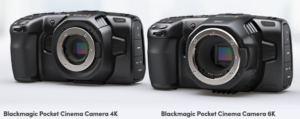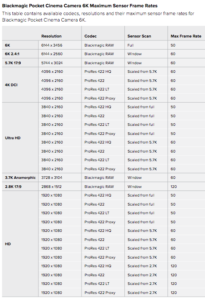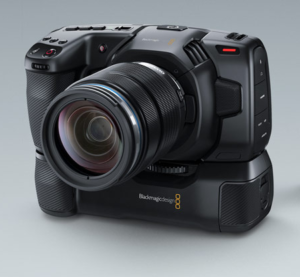 Hot topic of the moment is the Blackmagic Design Pocket6k, for which it seems that a general love of the filmakers has started and an indispensable need to sell what you already have to move to pocket6k.
Hot topic of the moment is the Blackmagic Design Pocket6k, for which it seems that a general love of the filmakers has started and an indispensable need to sell what you already have to move to pocket6k.
It is a common phenomenon that the new product is better than what we have because the period said by psychologists “honeymoon” is over and we see the instrument that we possess as useless or outdated. Basically I would have made a more balanced disanimation between the two cameras, but since they go more the xxx versus yyy, I split it all into two articles 😀
The pocket6k differs for a few things from the 4k version, for the management and support of new resolutions and a s35 format sensor, such as the UMP flagships, but otherwise there are no differences in dynamic range or performance really advantageous on pocket4k .
Now let’s do a practical reasoning on this “old camera” and see 10 reasons why it’s worth buying instead of pocket6k.
1) Economic factor
The pocket4k is available for about 1500 euros to the public, while the pocket6k costs 2500 euros to the public, so for the price of a room you almost take two pocket4k.
2) Storage
Using higher resolution, even with the braw or lighter prores formats the storage demands increase, the speed of the cards and disks to record this information will have to be greater, so you will have to make an additional investment both storage and recording, which not everyone is willing to do and little would make sense to take a 6k and record in 12:1 or in proresProxy (while in h264/h265… ) .
3) Shooting resolution
 The pocket 4k has the 4k (of course) DCI, UHD and the FHD with a 16:9 sensor that allows you to record in raw these resolutions, 4kDCI is the full sensor, UHD and FHD are recorded in sensor crop as on Arri, Red, Sony and all other chambers; in Prores all these resolutions without “windowed sensor” or without an additional crop.
The pocket 4k has the 4k (of course) DCI, UHD and the FHD with a 16:9 sensor that allows you to record in raw these resolutions, 4kDCI is the full sensor, UHD and FHD are recorded in sensor crop as on Arri, Red, Sony and all other chambers; in Prores all these resolutions without “windowed sensor” or without an additional crop.
The pocket 6k having a larger sensor in both size and resolution, in raw does NOT have the 4k or UHD not even “windowed”, but uses a 5.7k or 3.7K anamorphic windowed format to generate a format close to 4k or UHD. So for those who want to work in native 4k or UHD must take into account that with the pocket6k must scale or up or down the data, which will be very rich as information, but it is an extra stress to which they will submit their NLE.
4) We must have better lenses
 There are three reasons why the pocket4k is ahead of the lenses on the 6k, which is the same reason why the 4/3 is ahead of the aps-c and the ff.
There are three reasons why the pocket4k is ahead of the lenses on the 6k, which is the same reason why the 4/3 is ahead of the aps-c and the ff.
When using a lens, designed for a larger format, the maximum visual quality is in the middle, while as you go outside you have a very slight loss, depending on the quality and level of the lens, so using an original or vintage FF lens, a 4/3 cropping more format takes the best of the lens, a s35 with a smaller crop takes more sides and any defects, a FF sensor expects to have a perfect lens, otherwise it makes no sense to have invested in an FF sensor.
The second reason is that with the upper resolution also the connected lenses will have to be better, because otherwise it would not make sense to use a 6k sensor if you then put bottle bottoms in front of the sensor.
Having a Canon EF attack you have access to a good number of Canon, Sigma, Zeiss lenses that will offer excellent performances with such a camera.
The third advantage of Pocket4k is that the mount m4/3 has a short draw and allows the adaptation of almost any type of mechanical lens, vintage, allowing access to thousands of beautiful glasses of the last 100 years also of excellent quality, simply discarded because not autofocus.
5) Larger batteries
 A larger, higher-resolution sensor camera also requires more work power, so you have to reason either with the battery pack or with capacious external batteries in order to have a good autonomy. From the first indications it seems that if the Pocket4k absorbs 22w/h the pocket 6k should absorb about 26w/h so the durations should be similar, but… EF lenses have more greedy power stabilizers than m4/3 lenses, so using this different type of lens could drain our batteries quickly.
A larger, higher-resolution sensor camera also requires more work power, so you have to reason either with the battery pack or with capacious external batteries in order to have a good autonomy. From the first indications it seems that if the Pocket4k absorbs 22w/h the pocket 6k should absorb about 26w/h so the durations should be similar, but… EF lenses have more greedy power stabilizers than m4/3 lenses, so using this different type of lens could drain our batteries quickly.
6) More balanced sensor resolution ratio size 4k, 6k
The sensor resolution and size ratio is more favorable in the Pocke4k than the Pocket6k, where a slightly larger sensor divides the light it receives for more photoreceptors, so it’s more beneficial in cleaning in low light images.
7) Higher resolution, more detail, more possible problems
apart from the craving for resolution, which is often superior to human visual capacity, but that is another discourse already addressed, a greater solver of the 6k sensor without a high-frequency filter, offers the risk of more problems of moires and defects high-frequency sampling on many elements, while the 4k sensor being (in comparison) less resolute has less risk of moires.
8) The camera is new, let’s do the beta testers
As with each camera in each brand, the first wave of cameras is a paid beta, meaning you will test the general public how the room works, and if there are any problems or defects will be corrected in the run during production, while the pocket4k that is shipped from one year now has a verified and coordinated production line.
9) On Pocket4k you can have speedboosters, on the 6k ni
An engineering and technological miracle are the speedboosters of Metabone, an American company that creates lens adapters that contain a lens that concentrates light and offers two advantages : gain a diaphragm stop and crop reduction between FF and aps-c and 4/3,m4/3 formats.
Speedboosters have since been imitated by others, but the optical quality worth having a speedbooster to date has not yet been matched.
Speedboosters can only exist in the case of sensor lens pulls that give way to such a lens, which technically the EF mount does not do.
It seems that the company Lucadapter, which produces a variant to be inserted within the UMP, is thinking of producing the same thing for pocket6k, but for now it is still in the kickstarting phase, while for pocket4k there are both generics and the one dedicated for a long time.
10) Most powerful computers
 To handle both the prores and the braw 6k you will need to raise the bar of the power of computers, the speed of the raids to read the data and therefore not enough the simple room, but the investments expand in all the equipment.
To handle both the prores and the braw 6k you will need to raise the bar of the power of computers, the speed of the raids to read the data and therefore not enough the simple room, but the investments expand in all the equipment.
Of course my list is related to a purely general discourse, each then has different points of view, personally most of these points do not touch me, used to turn in uncompressed dng or other very expensive raw formats, I used the first Alexa with the firmware 0.85 that recorded fullHd prores, without audio, and I had so many varied experiences for which … I think these two machines are miracles given to the masses.
I’m waiting for you in the next article “Why pocket6k is better than Pocket4k”, so we reverse the situations…
